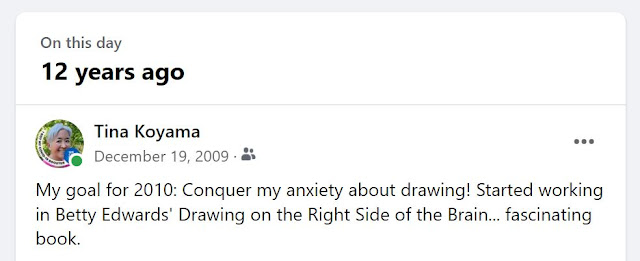Facebook pulled up an interesting “On this day” memory for me from Dec. 19, 2009:
The interesting part is that I didn’t begin what I think of now as my drawing commitment until September 2011. That means that for nearly two years after I declared my goal publicly on Facebook (and privately to myself in my journal; see below), I still continued to quit and restart, quit and restart, quit and restart. I remember well the cycle: A renewed burst of enthusiasm and excitement for learning to draw was usually prompted by a book, class or idea I had heard about. Eventually I would get discouraged and give up. Then something else would reignite my interest, and the cycle would begin again. Over and over.
 |
| 12/17/09 self-portrait |
Although I remember clearly the anxiety I had about drawing back then, it’s almost astonishing to realize that the same activity brings me so much joy and pleasure now. For continually pushing through the anxiety, fear, resistance, laziness, discouragement and whatever else I had encountered back then, I feel nothing but gratitude toward my former self.
Many individuals and organizations (Sketchbook Skool and Karen Abend’s Sketchbook Revival come to mind) are devoted to helping others develop a creative habit. I’m not one of those individuals. I don’t know how to explain how to do it – I can only serve by example here on my blog.
 |
| 12/7/09 journal entry (shortly before the public declaration on Facebook) |
As my annual year-end retrospective post, however, I thought I’d offer this: It’s OK if you stop drawing for a while. I don’t want to sound like a 12-step program or something, but learning to draw is a day-at-a-time thing. Just because you’ve stopped for a day or a month or 20 years doesn’t mean you can never go back to it. Someday the desire to draw will be stronger than not to draw, and you’ll be drawing again. Just draw again – even if it’s not forever. Someday, it might be.
 |
| 12/24/09 negative space exercise |
Tomorrow is the beginning of a fresh year. I hope it will include the joy of drawing for you as I know it will for me. Happy new year!
 |
| 1/11/10 negative space exercise |
 |
| 12/17/09 |




















































